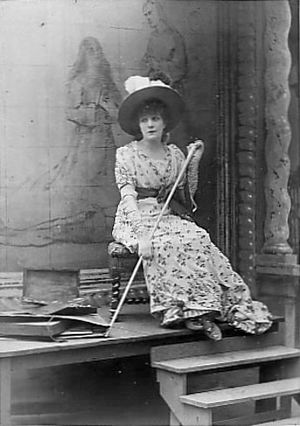Boyd's Theater and Opera House facts for kids
| Address | 1621 Harney Street Omaha, Nebraska United States |
|---|---|
| Coordinates | 41°15′24″N 95°56′15″W / 41.25655°N 95.93747°W |
| Owner | James E. Boyd, later Burgess-Nash Co. |
| Type | Theater and Opera House |
| Capacity | 2,000 |
| Opened | September 3, 1891 |
| Closed | February 2, 1920 |
| Years active | 1891–1920 |
The Boyd's Theater and Opera House was a famous place for shows and music in Downtown Omaha, Nebraska. It was located at 1621 Harney Street. This grand building was torn down in 1920. The land was then used for a big department store.
Contents
A Look Back at Boyd's Theater
The First Boyd's Opera House
The very first Boyd's Opera House was built in Omaha in 1881. It was located at 15th and Farnam Streets. James E. Boyd built it. He was a very successful businessman. He also served as Nebraska's governor and Omaha's mayor. A famous writer named Oscar Wilde even appeared there in 1882.
Building the New Theater
The first Boyd's Opera House burned down. So, James E. Boyd built a brand new one. This new theater was much bigger. It could hold 2,000 people! It was built at 17th and Harney Streets.
The new building was five stories tall. It had a strong iron frame. The outside was made of red bricks. There were shops on the ground floor. Offices were inside the building too. The whole project cost $250,000.
Inside the Grand Theater
The stage at Boyd's Theater was huge. It was 78 feet wide and 40 feet deep. The ceiling above the stage was 60 feet high! The main arch around the stage, called the proscenium, looked like a fancy arch from the Taj Mahal. The theater was decorated in soft green and olive colors. Electric lights made the whole place shine.
When the theater opened on September 3, 1891, it had 17 full sets of scenery. The first play performed there was Alabama. Thomas F. Boyd was the theater's manager.
Amazing Shows and Famous Stars
The Boyd Theater could handle very big shows. One play, Henry V, needed 10 train cars of armour. It also needed 200 trunks of costumes! There were 167 professional actors. When local actors joined, the cast grew to 300 people. The Boyd Theater was big enough for all of them.
Many famous actors performed at Boyd's Theater.
- English Shakespearean actors Sir Henry Irving and Dame Ellen Terry visited Omaha twice. They performed plays like Merchant of Venice and The Bells.
- Other stars included Otis Skinner, E. H. Sothern, John Drew, Walker Whiteside, Robert B. Mantell, Joseph Jefferson, Leslie Carter, Julia Marlowe, Ethel Barrymore, and Maude Adams.
In 1905, the very famous actress Sarah Bernhardt performed La Tosca at the Boyd Theater. She traveled in her own special train car. She even brought her own carriage, a team of black horses, and her French drivers! Everyone in Omaha knew when she was in town.
Omaha-born pianist Frances Nash also performed often at Boyd's Theater. She later married Edwin "Pa" Watson, who was a friend and advisor to President Franklin D. Roosevelt.
The Man Behind the Shows
William J. Burgess was the main person who made sure Boyd's Theater had great shows. He had worked in theaters since he was 12 years old. He managed other theaters in Omaha before coming to Boyd's. He wanted Boyd's to be the best theater in the city.
Burgess was very innovative. He started the first mail-order tickets in Omaha. He worked hard to book the best acts. He even opened an acting school! But times were changing. People started to prefer movies over live stage shows. Also, putting on live plays became more expensive.
The End of an Era
In 1914, Boyd's Theater was sold to the Burgess-Nash Company. They tried to keep it as a theater. But more and more people were going to see talking movies. Because of this, the company decided to close the theater.
The very last show at Boyd's Theater was on February 2, 1920. The building was torn down that same year. The land was then used for the company's department store. Today, the Omaha Public Power District's downtown office stands on that spot.


